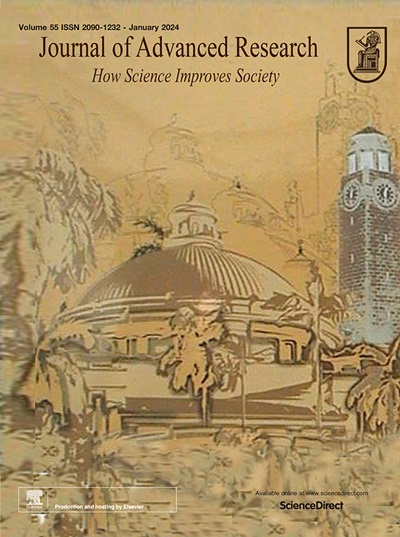大豆类黄酮3′-羟化酶的过度表达通过促进抗坏血酸的生物合成来增强植物的耐盐性
IF 13
1区 综合性期刊
Q1 MULTIDISCIPLINARY SCIENCES
引用次数: 0
摘要
盐胁迫是造成作物损失的主要原因。大豆(Glycine max)是全球重要的豆科作物,由于土壤盐碱化而面临越来越多的产量限制。已知类黄酮3′-羟化酶(f3′h)参与的类黄酮生物合成途径在耐盐性中起重要作用。然而,f3 ' h介导的耐盐性的精确分子基础仍然没有得到充分的表征。目的阐明F3'H蛋白在大豆耐盐性中的作用,探讨其多效性分子基础。作物优良新品种的创新有利于耐盐育种和生产应用。方法采用CRISPR/ cas9介导的基因敲除和农杆菌介导的基因过表达,在大豆中产生gmf3’h等位基因变异和异位表达。分别采用Sanger测序和qRT-PCR技术确认基因编辑的特异性,定量表达过表达转基因植株中的表达水平。通过亚细胞定位分析、酵母双杂交(Y2H)测定、LUC活性测定和植物生理测量,阐明了f3 ' h介导的植物耐盐分子基础。结果在大豆和拟南芥种子萌发期和幼苗期,黄酮类3′羟化酶基因(gmf3′h)是盐胁迫适应的主要调控因子。此外,我们的研究表明,进化上保守的F3'H蛋白竞争性地结合光形态形成因子COP9信号体亚基5B (CSN5B),并破坏其与gdp -甘露糖焦磷酸化酶1 (VTC1)的相互作用,VTC1是抗坏血酸生物合成的关键酶。这种竞争性抑制将代谢通量重定向到l -半乳糖途径,导致抗坏血酸(AsA)生物合成的增加。增强的AsA产量随后通过清除ROS来维持氧化还原稳态,从而提高植物幼苗的盐胁迫耐受性。结论f3 ' h介导的耐盐性的发现和鉴定为作物的遗传改良提供了重要的框架。这项工作为植物耐盐性提供了新的见解,并制定了创新的策略来增强广谱耐盐性,这是确保作物粮食安全的关键方面。本文章由计算机程序翻译,如有差异,请以英文原文为准。

Overexpression of soybean flavonoid 3′-hydroxylase enhances plant salt tolerance by promoting ascorbic acid biosynthesis
Introduction
Salt stress is a major cause of crop loss. Soybean (Glycine max), a globally vital legume crop, faces mounting yield constraints due to soil salinization. It is known that the flavonoid biosynthesis pathway involving flavonoid 3′-hydroxylase (F3′H) plays an important role in salt tolerance. However, the precise molecular basis of F3′H-mediated salt tolerance remains inadequately characterized.Objectives
This study aimed to elucidate the function and explore the pleiotropic molecular basis of F3′H protein in soybean salt tolerance. Innovation on elite new crop varieties facilitates breeding and production applications on salt tolerance.Methods
We employed CRISPR/Cas9-mediated knockout and Agrobacterium-based overexpression to generate GmF3′H allelic variants and ectopic expression in soybeans. Sanger sequencing and quantitative reverse transcription polymerase chain reaction (qRT-PCR) were used to confirm the specificity of gene editing and quantify expression levels in overexpression transgenic plants, respectively. As well as Subcellular localization analysis, Yeast two-hybrid (Y2H) assay, LUC activity assay and plant physiological measurements were carried out to elucidate the F3′H-mediated salt tolerance molecular basis in plants.Results
In this study, we identified the flavonoid 3′ hydroxylase gene (GmF3′H) in soybeans, which as a master regulator of salt stress adaptation during seed germination and seedling stages in both soybean and Arabidopsis thaliana. Furthermore, our study revealed that the evolutionarily conserved F3′H protein competitively binds to the photomorphogenic factor COP9 signalosome subunit 5B (CSN5B) and disrupts its interaction with GDP-mannose pyrophosphorylase 1 (VTC1), a key enzyme in ascorbate biosynthesis. This competitive inhibition redirects metabolic flux toward the L-galactose pathway, leading to an increase in ascorbic acid (AsA) biosynthesis. The enhanced AsA production subsequently improves seedling salt stress tolerance in plants by maintaining redox homeostasis through ROS scavenging.Conclusion
The discovery and characterization of F3′H-mediated salt tolerance provide a crucial framework for the genetic improvement of crops. This work provides new insights into plant salt stress tolerance and develops innovative strategies to enhance broad-spectrum salt tolerance, a crucial aspect for ensuring food security in crops.求助全文
通过发布文献求助,成功后即可免费获取论文全文。
去求助
来源期刊

Journal of Advanced Research
Multidisciplinary-Multidisciplinary
CiteScore
21.60
自引率
0.90%
发文量
280
审稿时长
12 weeks
期刊介绍:
Journal of Advanced Research (J. Adv. Res.) is an applied/natural sciences, peer-reviewed journal that focuses on interdisciplinary research. The journal aims to contribute to applied research and knowledge worldwide through the publication of original and high-quality research articles in the fields of Medicine, Pharmaceutical Sciences, Dentistry, Physical Therapy, Veterinary Medicine, and Basic and Biological Sciences.
The following abstracting and indexing services cover the Journal of Advanced Research: PubMed/Medline, Essential Science Indicators, Web of Science, Scopus, PubMed Central, PubMed, Science Citation Index Expanded, Directory of Open Access Journals (DOAJ), and INSPEC.
 求助内容:
求助内容: 应助结果提醒方式:
应助结果提醒方式:


